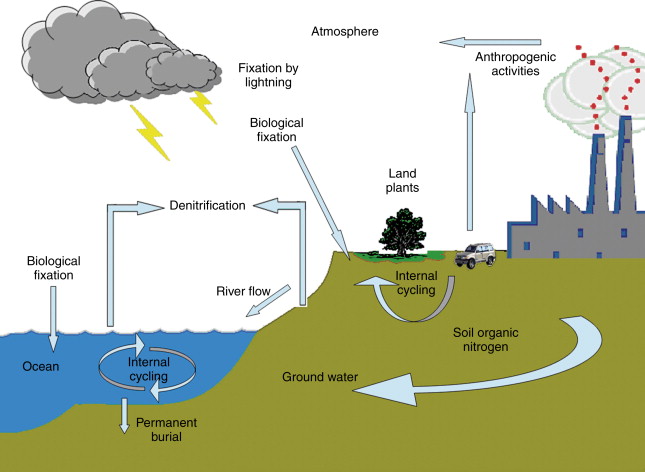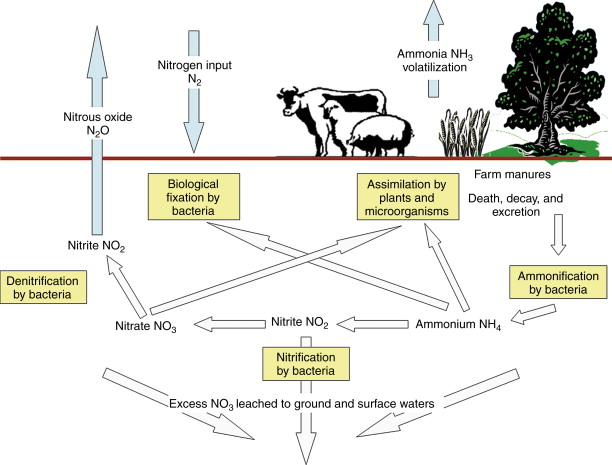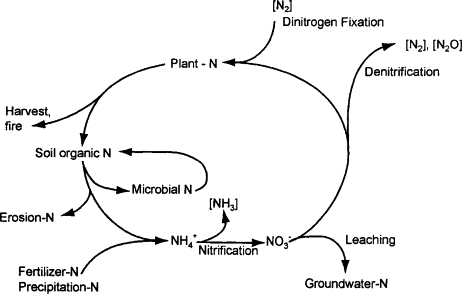NITROGEN CYCLE- PROCESS & IMPORTANCE
Introduction
Nitrogen cycle refers to the movement of nitrogen across different reservoirs, including living organisms, in different forms via chemical processes.
- Nitrogen cycleis one of the most important nutrient cycles in terrestrial ecosystems. Since, Nitrogen is an essential constituent of DNA, RNA, and proteins, hence is required for all organisms.
- Nitrogen comprises approximately 79% of the Earth’s atmosphere in the form of biologically unavailable (N2) gas. This reservoir constitutes approximately 90% of the global reservoir whereas; remaining 10% is comprised by Crustal reservoirs.
- Atmospheric nitrogen, though representing the largest reservoir, cannot be readily used by most organisms. The amount of N stored in the terrestrial and oceanic biomass, and soil is small, but is the vital component as far as living organisms are concerned.
- Nitrogen was discovered in 1772 by Daniel Rutherford, who called the gas ‘noxious air’.
- Nitrogen fixation influences the amount of food present within an ecosystem.
Global N-cycle
The global nitrogen cycle is driven by biological and physical processes, which depend on various environmental factors such as solar energy, precipitation, temperature, soil texture, soil moisture, the presence of other nutrients, and atmospheric CO2 concentrations.

- Because of high decomposition rates, Tropical forest soils show the least amount of storage whereas, due to the higher production rates, vegetation in temperate and tropical forests have higher N storage.
- In agriculture, Nitrogen must be available in inorganic formal ammonia (NH3), ammonium (NH4), nitrite, (NO2), or nitrate (NO3) for plant use. In the terrestrial nitrogen cycle, soil nitrogen cycling processes dominate, with application of fertilizer and manure providing most of the nitrogen inputs.
- Microbes break down organic matter to produce much of the available nitrogen in soils. The process of Mineralization/immobilization, nitrification, nitrate leaching, denitrification, and plant uptake can then occur.
- Nitrate is completely soluble in water and since it is not adsorbed to clay particles, it is vulnerable to being leached out of the soil by percolating water.
Generally, the movement of nitrogen can occur in one of three directions:
- Upward- crop uptake and gaseous loss,
- Downward- as leaching to groundwater, and
- Lateral- via surface and subsurface flow to surface waters.
- Anthropogenic activities such as, land-use changes, such as intensive agriculture, over-fertilization, deforestation, biomass burning, and combustion of fossil fuels, industrial activities, and energy production greatly affects the Nitrogen cycle.
- Nutrient uptake of cultivated crops ranges from about 100 kg N/ha/yr for wheat and up to 450 kg N/ha/yr for sugar cane.
- The mineralization capacity of soils is almost always insufficient to maintain optimum growth; therefore, chemical fertilizers and manures are applied to supply N for intensive agriculture.

Nitrogen cycle and Reactive nitrogen
- Different steps of the nitrogen cycle are mostly driven by microorganisms.
- Most plants get the nitrogen from the soil or water in which they grow. Animals get nitrogen by consuming these plants. When the plants and animals perish, the bodies decompose bringing the nitrogen back to land and water.
- Humans influence the global nitrogen cycle in a major way and account for more than 75% of the reactive nitrogen primarily through agriculture and increased fossil fuel consumption to fulfill the demand for food and energy for the rapidly growing population.
- Nitrogen gas that constitutes almost the total nitrogen in air is unreactive, while other inorganic N compounds that are present in traces, such as ammonia, ammonium ion, nitrous oxide, nitric acid, nitrogen oxides, nitrogen pentaoxide, peroxyacetyl nitrate, nitrate ions, and organic compounds such as urea, amines, amides, and proteins, constitute the reactive form and play an important role in global biogeochemical cycles.
- Crops and animal activities are associated with spike in ammonia and N2O concentration.
- The N2O has approximately 300 times the global warming potential of carbon dioxide and is one of the important greenhouse gases in Earth’s atmosphere.
- Ammonia is the major alkaline component, present abundantly in the atmosphere that regulates atmospheric acidity and is also an important source of atmospheric aerosols. The deposition of Ammonia contributes to soil acidification through oxidation of the deposited ammonia to acidic compounds.
Crop Nitrogen use and Soil Nitrogen loss
- Nitrogen in the biosphere exists in a number of different oxidation states, each of which is differentially available to plants, microbes, and other organisms and each of which is differentially reactive with the chemical and physical environment.
- In a typical row-crop ecosystem, Nitrogen enters the plant in inorganic form primarily as nitrate (NO3−), and ammonium from the soil solution.
- Leguminous crops can also acquire significant nitrogen from the atmosphere. At harvest, some proportion of the aboveground plant nitrogen is removed from the system with the crop yield; the remainder, as well as nitrogen contained in roots, joins the crop residue pool as soil organic nitrogen.

Crop-Nitrogen use & Soil-N Loss(Courtesy-sciencedirect.com) - In agricultural soils ammonium is usually quickly nitrified to nitrate, which will be subject to leaching, denitrification, and also available again for plant uptake. It can be supplemented Manure and, more commonly, urea-N can be added to the organic N pool, and inorganic fertilizers can supplement the ammonium and nitrate pools.
- In most soils urea-N quickly hydrolyzes to the ammonium pool and for both urea and anhydrous ammonia a significant portion of the added nitrogen can be volatilized as NH3within a few days of application.
Frequently Asked Question (FAQ)
What is Nitrogen Cycle?
Nitrogen cycle refers to the movement of nitrogen across different reservoirs, including living organisms, in different forms via chemical processes
What is the N-content in earth’s atmosphere?
Approx.79%
Which form of Nitrogen is vulnerable to being leached out of the soil by percolating water?
Since Nitrate is completely soluble in water and is not adsorbed to clay particles, it is vulnerable to being leached out of the soil by percolating water.